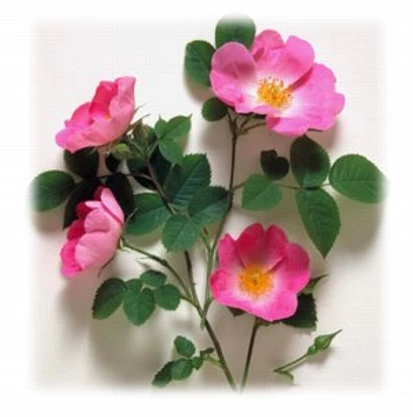The Wild Roses
The Myths
In addition to the wild medieval tales of love and magic, the rose has many myths around it that are alive today. For example, if you’re really informed about what a “wild rose” is, you’re one of a tiny minority. First of all, that wonderful old pink, fluffy rose that your grandmother called “wild,” wasn’t. Most of the roses you see around old abandoned homesites aren’t wild either. They’re just tough. Since roses have been hybridized since Roman times, there are thousands of tough, long-lived hybrids that seem to grow on forever.
The True “Wild” Roses
The botanical term for wild rose is “species rose”, which means just what it says — a species that occurs naturally, with no help from man — a true “wildflower.” There are over 100 of these worldwide, some native to North America, many from the Orient and Europe. These true wild roses are all single with exactly five petals — never more, and almost all of them are pink, with a few whites and reds, and even fewer that range toward yellow. (By the way, there are now over 20,000 hybrids, with about 200 new ones every year.)
North American Native Roses
Two of the most widespread species roses you may see are Rosa carolina, or the Carolina Rose, common in thickets, and Rosa palustris, commonly called “Swamp Rose”, since it grows in wet ground. Both are rather small, scrambling shrubs with spectacular, 2″ wide-open single blooms with five bright pink petals. And both are native to a huge area from the entire Atlantic seaboard all the way west to Nebraska.
Further west, Rosa blanda is the pink-fading-to-white-flowered climbing shrub usually called “Prairie Rose”. It’s native from Ontario down into Texas, and west to the Rockies.
From the Rockies through the Cascades, a very hardy favorite is Rosa woodsii, or “Wood’s Wild Rose”. Along the upper Pacific coast from Alaska down into California, a famous wild rose is Rosa nutkana, known as “The Nootka Rose.” And of course, there is a Rosa californica, native west of the Sierra Nevada. All these westerners are pink. There are others, and every region has it’s favorite.
Most all North American native roses look a lot like the large photo above, pink with exactly five petals. Most of the native rose plants are smallish shrubs, with canes no longer than three or four feet.
Imported Wild Roses
More commonly seen are two wild roses that are used extensively in landscaping in North America.
R. rugosa
This is the tough, thorny shrub with the deeply-veined dark green leaves. If they’re in flower (heavily in June), you’ll see both red and white types, and in late summer, the famous rugosa apple-shaped hips are quite showy. These beautiful shrubs are so tough, they’re grown everywhere from fancy rose gardens to grocery store parking lots. The rugosas are native to the Far East, and neither salt spray nor bitter cold hurts them a bit. In fact they will grow almost anywhere with sun, from northern Canada to our southern beaches.
Multiflora Rose
R. multiflora
This is the rangy, small-leaved shrub with sprays of one-inch white single roses in June. This rose is native to Japan and Korea, but has been used extensively in the U.S. as a “living fence.” It wasn’t such a great fence, since in our mid-Atlantic states it has become an invasive pest. It’s also very prevalent along the Maine coast — beautiful in bloom, but a real problem to contain.
The Romance of the Wild Rose
Of course, roses are probably the No. 1 symbol of love in human history. We’ve even had a War of the Roses, not to mention centuries of rose perfumes, oils, medicines, and foods. Today in the US, the “wild rose” competes with the violet as our most popular state flower; both are the symbols of several states. And even though the fantastic new roses offer you almost anything you may desire in color or fragrance, many people think there is no purer beauty than the true wild rose.
After all, Emily Bronte wrote, “Love is like the wild rose.” And Robert Burns did not write his most famous love poem about some gaudy, man-made, orange and pink creation, but stated clearly and simply, “My love is like a red, red rose.” (Read the famous Robert Burns poem below). But it was surely Gertrude Stein who summed it up best, with her her classic line about the rose’s incomparable beauty: A rose is a rose is a rose.” She did not write “A rose is a rose is a bi-colored hybrid.”
What’s Available for Wild gardeners Today: The Miraculous “Nearly Wild” Roses.
There are some species roses available from specialist nurseries, but by and large, gardeners who love the look of a wild rose are using some “newer” plants that have all the good qualities of the originals, but all kinds of wonderful new qualities, too.
First of all, most species roses bloom for only about two weeks each year. That’s great if you happen to be there, but if you miss it, you’ll have to wait a whole year for more. That’s why many of the new “landscape” or “shrub” roses combine the convenient size of the species shrubs with the wonders of repeat blooming. A lot of this has been done by crossings with the fabulous rugosa rose species from the Far East. It has the incomparable combination of large flowers, tremendous toughness even in the coldest temperatures, and best of all, repeat blooming all season long. No other species rose has all these qualities.
So today, “shrub roses” like Carefree Beauty, Carefree Delight, Chuckles, and the one actually named “Nearly Wild” (photo at right) all offer the loveliness and low-maintenance of wild roses with the added qualities of incredible cold hardiness plus the magic of repeat bloom. Other popular “carefree” roses includs the famous “Bonica” and more recently, the “Knock Out” series. They are some of the most carefree roses available, but they don’t have the classic 5-petaled “wild rose” bloom.
To the purist, none of these are true “wildflowers”, but for most wildgardeners, they’re a miracle. And in any wildflower meadow, they easily hold center stage whenever they’re in bloom.
My Love is Like a Red, Red Rose by Robert Burns (1759 – 1796)
O my Luve’s like a red, red rose That’s newly sprung in June: O my Luve’s like the melodie That’s sweetly play’d in tune!
As fair art thou, my bonnie lass, So deep in luve am I: And I will luve thee still, my dear, Till a’ the seas gang dry:
Till a’ the seas gang dry, my dear, And the rocks melt wi’ the sun; I will luve thee still, my dear, While the sands o’ life shall run.
And fare thee weel, my only Luve, And fare thee weel a while! And I will come again, my Luve, Tho’ it were ten thousand mile.




